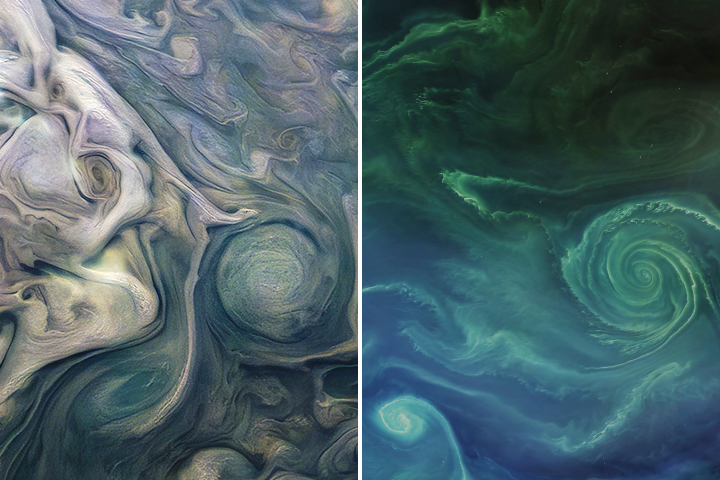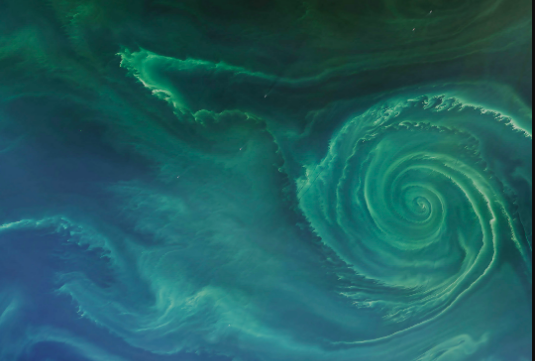Jupiter or Earth?
EarthSky Voices in TODAY'S IMAGE | March 17, 2019
Swirls in Jupiter’s atmosphere and in Earth’s Baltic Sea look a lot alike. That’s because the motion of fluids on both planets are governed by same laws of physics.
Swirls in Jupiter’s atmosphere (left) and swirls in Earth’s Baltic Sea (right).
Jupiter is a gaseous planet – biggest planet in our solar system – with more than 11 times the diameter of Earth. But both Jupiter and Earth are governed by the same laws of physics. And that’s why a swirling eddy in Earth’s ocean looks a lot like a swirling eddy in Jupiter’s thick atmosphere. The similarities are evident in these images showing swirls in Jupiter’s atmosphere and in Earth’s Baltic Sea. Norman Kuring, of NASA’s Goddard Space Flight Center, said:
This is all about fluids moving around on a rotating body.
Kuring described the patterns of flow as a combination of laminar (following a smooth path) and turbulent (uneven and chaotic). Flows can be characterized using numbers named for famous physicists, such as Reynolds, Rossby, and Rayleigh. But you don’t need a textbook knowledge of fluid dynamics to appreciate its consequences. Kuring said:
Out of all the complexity flows beauty, whether it be images of Earth, Jupiter, or your coffee cup when you pour in the cream.
Image acquired by the JunoCam imager on NASA’s Juno spacecraft in December 2018.
Scientists think Jupiter has three distinct cloud layers. The image above, taken by the Juno spacecraft, shows ammonia-rich clouds swirling in the planet’s outermost layer.
According to Alberto Adriani, a Juno mission co-investigator from the Institute for Space Astrophysics and Planetology, the eddies in Jupiter’s clouds reflect disturbances in the atmosphere caused by the planet’s fast rotation and by higher temperatures deeper in the atmosphere. He compares the phenomenon to rapidly rotating a fluid while boiling it.
Operational Land Imager (OLI) on Landsat 8 acquired this image on July 18, 2018.
The patterns in Jupiter’s atmosphere appear similar to those in Earth’s oceans. The natural-color satellite image above shows a green phytoplankton bloom tracing the edges of a vortex in the Baltic Sea. In this medium – Earth’s ocean – turbulent processes are important for moving heat, carbon, and nutrients around the planet. Models that accurately represent these processes are critical for understanding weather in the air and sea.
While scientists continue exploring the complexities of Earth’s oceans, astronomers are learning more about Jupiter’s complex composition – important for understanding how our solar system and other solar systems formed. Kuring said:
In interpreting what we see elsewhere in the solar system and universe, we always compare with phenomena that we already know of on Earth. We work from the familiar toward the unknown.
 |
 |
|
|||||||||||
 |
 |
||||||||||||
|
|
|
|
|
|
|
||||||||
 |
|
|
|
|
|
 |
|||||||
|
|
|
|
|||||||||||
|
|
|||||||||||||
|
|
|
|
|
|
|
|
|
|
|
|
|
|
|
Results 1 to 1 of 1
-
03-23-2019, 12:24 PM #1
Swirls in Jupiter’s atmosphere and in Earth’s Baltic Sea look a lot alike
Beginner's Guide for Rocket, NFPS and IKS66...
http://iptvtalk.net/showthread.php?2...-you-should-do
Kodi Options for Rocket, NFPS and IKS66...
http://iptvtalk.net/forumdisplay.php?71-Kodi
Check the Announcement Section...
http://iptvtalk.net/forumdisplay.php...-Announcements
Similar Threads
-
Asteroid flyby ... just skimmed Earth’s atmosphere
By ilan in forum The Universe Closer to HomeReplies: 0Last Post: 11-17-2020, 01:18 PM -
Fireball entering Earth's atmosphere - video
By ilan in forum The Universe Closer to HomeReplies: 0Last Post: 09-05-2019, 04:12 PM -
Asteroid 2019 MO exploded in our atmosphere
By ilan in forum The Universe in ReviewReplies: 0Last Post: 06-27-2019, 12:03 PM -
Earth’s atmosphere extends beyond moon
By ilan in forum The Universe Closer to HomeReplies: 0Last Post: 02-21-2019, 01:13 PM -
Earth-like exoplanets are indeed Earth-like
By ilan in forum The Universe in ReviewReplies: 0Last Post: 07-16-2018, 12:00 PM










 Reply With Quote
Reply With Quote